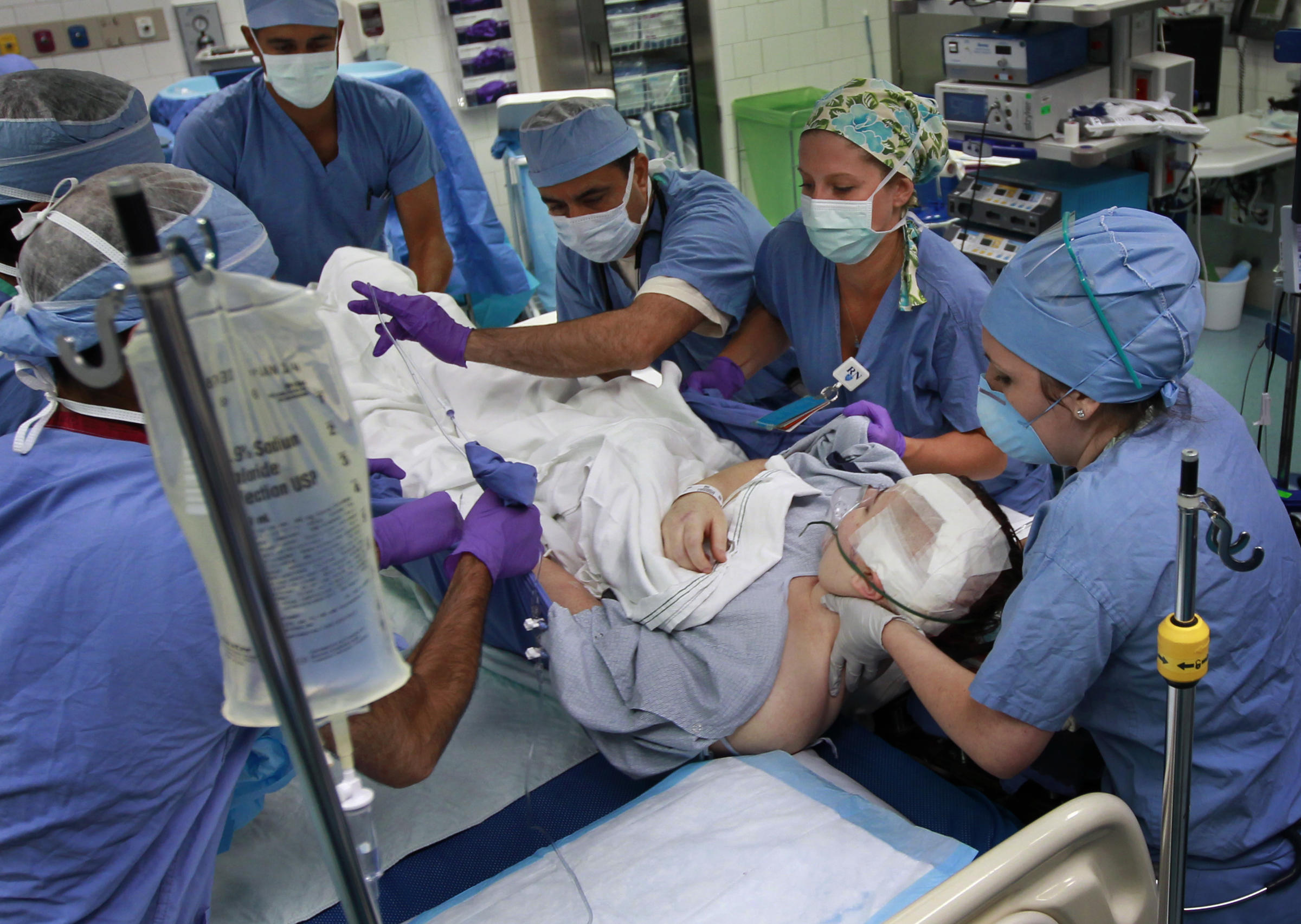Why So Many Nurses Get Hurt On The Job, Including In Georgia

Veteran nurses in Georgia say the heavier weights of patients should be considered a nurse job safety issue.
Steven Senne / Associated Press
In 2015, about five of every 1,000 registered nurses in the United States missed work due to injury, according to the federal Bureau of Labor Statistics. Back injuries in particular are the scourge of the nursing profession.
“I think in every job there are hidden risks,” Paige Cummings, director of the Athens Nurses Clinic, said to Georgia Health News. These are perils “that people in that area are very aware of and people on the outside may not be.”
According to a different analysis, nurses rank 11th among categories of workers most likely to be hurt on the job. There are relatively few occupations that are more hazardous, and most of those involve what’s traditionally considered “hard labor.” The average person just doesn’t think of nursing as tough physical work.
But often that’s exactly what it is.
“Nursing graduates face the dangers of heavy lifting, and we know that even the best body mechanics will not protect them from cumulative, debilitating musculo-skeletal injuries,” said Lucy Marion, dean of the College of Nursing at Augusta University.
The College of Nursing advises all its graduates to seek out safe work environments to protect themselves from injury.
Registered nurse Margie Nicolaus has been practicing for 39 years, always in a hospital setting. She now works at St. Mary’s Hospital and the Athens Nurses Clinic.
“You know, it’s really hard physical work, it’s not just mental, it’s also a lot of physical work, we have to lift patients, help patients in and out of bed,” she said, “so injury happens.”
Some nurses are hurt in one specific incident, as when a patient’s transfer from a gurney to a bed goes wrong. Other nurses suffer the cumulative effects of lifting and moving patients. Many nurses, but not all, recover from their injuries after taking a break.
“There have been other nurses or technicians who have injured their backs so badly,” said Cummings. “They weren’t able to work anymore.”
Bigger patients, harder work
Patients are also getting heavier. The increasing average weight of the population means an extra risk to nurses who have to handle patients. CDC figures show that the percentage of adult Americans considered obese rose from 30.5 to 37.7 percent between 2000 and 2014.
“I’m an old nurse, so I feel like I’ve had my share of hard physical work,” said Nicolaus. “Especially now we have a lot of patients who have a BMI [body mass index] much higher than they used to.”
Cummings believes patients’ weight should be considered a nurse safety issue.
“As America gets heavier, there need to be more safety/preventative measures and/or assisted devices to prevent back injuries,” she said.
“After 42 years, I haven’t had a significant work injury,” said Cummings. She has nursed in a number of health care settings, including Navy hospitals, home health situations and for the Red Cross.
Susan Smith, who also practices at the Athens Nurses Clinic, had neck surgery in 1998.
The surgeon asked her whether a workplace injury caused her neck problems, but Smith couldn’t think of one triggering event. She blamed the wear and tear of two decades on the job for the damage to her neck. Now, nearly 20 years after neck surgery, she’s still doing the job, and said recently, “My back’s killing me right now!”
Nicolaus, who has worked mostly in hospital settings, has persistent shoulder pain. She attributes this to the physical demands of her job.
National organizations, state legislatures and individual medical systems are acting to protect nurses from injury.
The Nurse and Health Care Worker Protection Act of 2015, which would support workplace safety nationally, is currently being reviewed in Congress. This bill is supported by organizations such as the American Nurses Association.
Adjusting training to promote safety
Nursing schools emphasize using good body mechanics to help decrease the risk of injury, with many using materials such as the Handle With Care fact sheet created by the American Nurses Association.
Some states require hospitals to offer special training for nurses so they can handle patients more safely.
“Eleven states now have some form of law or legislation related to institutions having a safe patient handling program,” said Lorie Arata, a nurse practitioner in the Employee Health Clinic at Piedmont Athens Regional and who works with safe patient handling and mobility. “Georgia isn’t one of those states yet, but we don’t want to wait until we are forced to do it.”
Special lifts and transfer equipment help nurses and technicians stay safe while moving patients, and the emphasis on using these devices has been stressed for the past 10 years, Arata said.
Piedmont Athens Regional now requires all new employees to take a safe patient handling class as part of their orientation.
After training, the safe patient handling resources are available on the hospital’s intranet for continued use by the staff.
“We’ve seen nearly a 40 percent reduction in injuries from 2015 to 2016,” said Arata.
Even though training and frequent reminders appear to decrease the risks associated with nursing, injuries still happen.
Nurses often act fast and risk injury to themselves because the situation demands it.
“Younger nurses sometimes say to you, ‘I’d let them fall, I’m not going to throw my back out for a patient,’ ” Smith said. But when those young nurses actually see a patient in danger of falling, they spring into action, she noted.
Though nurses may talk about looking out for themselves first, they are “by nature caretakers, caregivers,” said Cummings. Given that sense of duty, sometimes nurses’ injuries, and the pain that comes with them, may be unavoidable.
“The one complaint I hear from more people,” said Cummings, “is, ‘Oh, my aching back.’ ”
Naomi Thomas is a graduate student at UGA pursuing a master’s degree and career in Journalism. She received her undergraduate degree in Media, Communication and Cultures from Leeds Metropolitan University and has an interest in health workforce stories.





